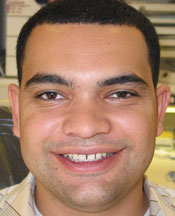Background - What's Behind Your Patient
What is behind or around the patient may not seem that imposrtant until a smile portrait is made of the patient. A busy background can have unintended results:
- The tones and shapes in the background may distract the attention away from the portrait.
- The hair may blend in with parts of the background.
- Smile portraits made in the dental chair are often too high making the creating of a smile simulation difficult. With all the dental equipment it maybe difficult to get back far enough and if you are using a zoom lens, the face will often times be distorted because of being too close to the patient with the camera.
- Having dental equipment in the background may, subliminally, turn the patient away from having a cosmetic procedure because of the amount of time needed to spend in the chair.
Which Photo do You Think is Better?
 |
 |
There is a lot of competition for the eye's attention in the left photo. Similar tones, and many light and dark patterns. Notice how you almost have to visually eliminate the background so you can place your attention on the face. While the photo on the right almost jumps out at you because there is nothing for the eye to be distracted by in the background.
A blue background often is a good choice because of the separation between the patient's hair and the blue. (Blue poster board mounted on foam core is available at most office supply stores).
Patient Photographed in the Dental Chair.
 |
 |
The photo on the left has a distracting background. The goal is to take a smile portrait that is pleasing to the patient. You want them to focus on the end result of how beautiful their smile will look. You don't want to emphasize the process of what they will have to go through to get there, so it's best to leave out the chair and equipment. Most likely they will be more relaxed out of the dental chair. The photo should be straight on, which is more difficult if they're in the chair. Often photos taken in the chair present the patient at an unflattering angle and can also be more difficult to create realistic smile simulations.
I know you are not a portrait studio, but it really is not too difficult to create a smile portrait that the patient will like (or at the very least not dislike).
- Set-up a small area in your office where you will make smile portraits.
- Hang blue posterboard on the wall.
- Make a mark on the floor where the patient should stand.
- Make another mark on the floor where you will stand.
- Take a number of photos (usually the patient will not like the first few).
- If the patient will not smile enough, have them say "Cheese".
- Ask the patient which one they like the best.

